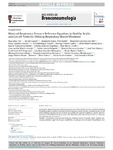Maximal respiratory pressure reference equations in healthy adults and cut-off points for defining respiratory muscle weakness

View/
Use this link to cite
http://hdl.handle.net/2183/33881
Except where otherwise noted, this item's license is described as Creative Commons Atribución-NonCommercial-NoDerivs 4.0 Licence International (CC-BY-NC-ND 4.0)
Collections
- Investigación (FFISIO) [474]
Metadata
Show full item recordTitle
Maximal respiratory pressure reference equations in healthy adults and cut-off points for defining respiratory muscle weaknessAuthor(s)
Date
2023-09Citation
Lista-Paz A, Langer D, Barral-Fernández M, Quintela-Del-Río A, Gimeno-Santos E, Arbillaga-Etxarri A, Torres-Castro R, Vilaró Casamitjana J, Varas de la Fuente AB, Serrano Veguillas C, Bravo Cortés P, Martín Cortijo C, García Delgado E, Herrero-Cortina B, Valera JL, Fregonezi GAF, González Montañez C, Martín-Valero R, Francín-Gallego M, Sanesteban Hermida Y, Giménez Moolhuyzen E, Álvarez Rivas J, Ríos-Cortes AT, Souto-Camba S, González-Doniz L. Maximal respiratory pressure reference equations in healthy adults and cut-off points for defining respiratory muscle weakness. Arch Bronconeumol. 2023 Dic;59(12):813-820.
Abstract
[Abstract] Introduction: Maximal inspiratory and expiratory pressures (PImax/PEmax) reference equations obtained in healthy people are needed to correctly interpret respiratory muscle strength. Currently, no clear cut-off points defining respiratory muscle weakness are available. We aimed to establish sex-specific reference equations for PImax/PEmax in a large sample of healthy adults and to objectively determine cut-off points for respiratory muscle weakness.
Methods: A multicentre cross-sectional study was conducted across 14 Spanish centres. Healthy non-smoking volunteers aged 18-80 years stratified by sex and age were recruited. PImax/PEmax were assessed using uniform methodology according to international standards. Multiple linear regressions were used to obtain reference equations. Cut-off points for respiratory muscle weakness were established by using T-scores.
Results: The final sample consisted of 610 subjects (314 females; 48 [standard deviation, SD: 17] years). Reference equations for PImax/PEmax included body mass index and a squared term of the age as independent variables for both sexes (p<0.01). Cut-off points for respiratory muscle weakness based on T-scores ≥2.5 SD below the peak mean value achieved at a young age were: 62 and 83cmH2O for PImax and 81 and 109cmH2O for PEmax in females and males, respectively.
Conclusion: These reference values, based on the largest dataset collected in a European population to date using uniform methodology, help identify cut-off points for respiratory muscle weakness in females and males. These data will help to better identify the presence of respiratory muscle weakness and to determine indications for interventions to improve respiratory muscle function.
Keywords
Adults
Healthy volunteers
Maximal respiratory pressures
Muscle strenght
Reference values
Respiratory function tests
Respiratory muscles
Healthy volunteers
Maximal respiratory pressures
Muscle strenght
Reference values
Respiratory function tests
Respiratory muscles
Editor version
Rights
Creative Commons Atribución-NonCommercial-NoDerivs 4.0 Licence International (CC-BY-NC-ND 4.0)
ISSN
0300-2896
Related items
Showing items related by title, author, creator and subject.
-
Análisis comparativo de los valores de las presiones respiratorias máximas con los valores de referencia en una población adulta sana
Lista-Paz, Ana; Souto-Camba, Sonia; Vilaró Casamitjana, J.; Quintela-del-Río, Alejandro; López García, Asenet; González Doniz, Luz (Elsevier, 2019-05-09)[Resumen] Antecedentes y objetivo. La determinación de las presiones respiratorias máximas es un procedimiento no invasivo de gran utilidad clínica para la evaluación de la fuerza de los músculos respiratorios. El objetivo ... -
Comparison of two protocols for the assessment of maximal respiratory pressures: Spanish Society of Pulmonology and Thoracic Surgery versus American Thoracic Society/European Respiratory Society
Lista-Paz, Ana; Sancho Marín, Sergio; Souto-Camba, Sonia; Jácome, Cristina; González Doniz, Luz (Cureus, 2021-10-29)[Abstract] Background. The measurement of maximal respiratory pressures (MRPs) is commonly used to assess respiratory muscle strength. However, in Spain, there is no consensus on which is the most adequate measurement ... -
Análisis comparativo y actualización de los valores sobre función pulmonar, fuerza y resistencia de la musculatura respiratoria en personas con y sin fibromialgia: un proyecto de investigación
Regueira Losada, Marcos (2023-06)[Resumen] Introducción La fibromialgia se define como una afección crónica idiopática que constituye un síndrome caracterizado por dolor musculoesquelético no inflamatorio difuso y generalizado, con baja tolerancia al ...






